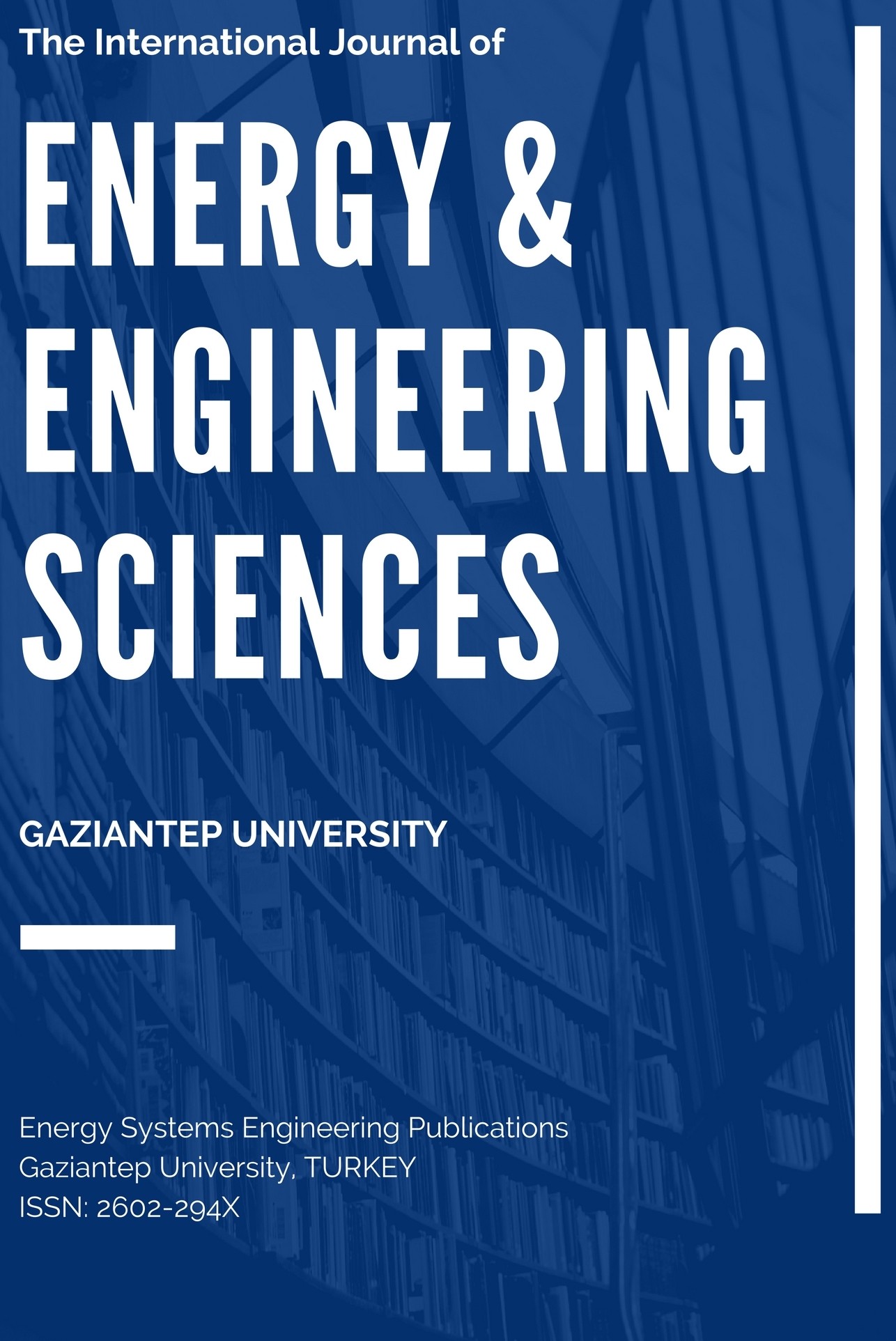OPTIMIZATION OF SPACING BETWEEN STAGGERED METAL HYDRIDE TANKS INTEGRATED FUEL CELL SYSTEM
OPTIMIZATION OF SPACING BETWEEN STAGGERED METAL HYDRIDE TANKS INTEGRATED FUEL CELL SYSTEM
Hydrogen Storage, Metal Hydrides, Forced Convection,
___
- Aldas K, Mat MD, Kaplan Y (2002) A three-dimensional mathematical model for absorption in a metal hydride bed. International Journal of Hydrogen Energy 27 (10):1049-1056. doi:http://dx.doi.org/10.1016/S0360-3199(02)00010-1.
- Bao Z, Yang F, Wu Z, Nyallang Nyamsi S, Zhang Z (2013) Optimal design of metal hydride reactors based on CFD–Taguchi combined method. Energy Conversion and Management 65:322-330. doi:http://dx.doi.org/10.1016/j.enconman.2012.07.027.
- Bejan A (1984) Convection Heat transfer. Wiley, New York. Cho J-H, Yu S-S, Kim M-Y, Kang S-G, Lee Y-D, Ahn K-Y, Ji H-J (2013) Dynamic modeling and simulation of hydrogen supply capacity from a metal hydride tank. International Journal of Hydrogen Energy 38 (21):8813-8828. doi:http://dx.doi.org/10.1016/j.ijhydene.2013.02.142
- Dhaou H, Ben Khedher N, Mellouli S, Souahlia A, Askri F, Jemni A, Ben Nasrallah S (2011) Improvement of thermal performance of spiral heat exchanger on hydrogen storage by adding copper fins. International Journal of Thermal Sciences 50 (12):2536- 2542. doi:http://dx.doi.org/10.1016/j.ijthermalsci.2011.05.016
- Førde T, Eriksen J, Pettersen AG, Vie PJS, Ulleberg Ø (2009) Thermal integration of a metal hydride storage unit and a PEM fuel cell stack. International Journal of Hydrogen Energy 34 (16):6730-6739. doi:http://dx.doi.org/10.1016/j.ijhydene.2009.05.146
- Hilali I (2015) Optimum Spacing Between Horizontal Metal Hydride (MH) Hydrogen Storage Tanks Integrated with Fuel Cell Power System in Natural Convection. Journal of Thermal Scienceand Technology 35 (2):129-136
- Incropera FP (2007) Fundamentals of Heat and Mass Transfer. John Wiley & Sons, New York
- Jemni A, Nasrallah SB (1995) Study of two-dimensional heat and mass transfer during absorption in a metal-hydrogen reactor. International Journal of Hydrogen Energy 20 (1):43-52. doi:http://dx.doi.org/10.1016/0360-3199(93)E0007-8.
- Jiang Z, Dougal RA, Liu S, Gadre SA, Ebner AD, Ritter JA (2005) Simulation of a thermally coupled metal-hydride hydrogen storage and fuel cell system. Journal of Power Sources 142 (1-2):92-102. doi:10.1016/j.jpowsour.2004.09.029.
- Ma J, Wang Y, Shi S, Yang F, Bao Z, Zhang Z (2014) Optimization of heat transfer device and analysis of heat & mass transfer on the finned multi-tubular metal hydride tank. International Journal of Hydrogen Energy 39 (25):13583-13595. doi:http://dx.doi.org/10.1016/j.ijhydene.2014.03.016.
- MacDonald BD, Rowe AM (2006) Impacts of external heat transfer enhancements on metal hydride storage tanks. International Journal of Hydrogen Energy 31 (12):1721- 1731. doi:http://dx.doi.org/10.1016/j.ijhydene.2006.01.007.
- Minko KB, Artemov VI, Yan’kov GG (2014) Numerical simulation of sorption/desorption processes in metal-hydride systems for hydrogen storage and purification. Part I: Development of a mathematical model. International Journal of Heat and Mass Transfer 68:683-692. doi:http://dx.doi.org/10.1016/j.ijheatmasstransfer.2013.09.056.
- Nakano A, Ito H, Bhogilla SS, Motyka T, Corgnale C, Greenway S, Hauback BC (2015) Research and development for a metal hydride tank with double coil type heat exchanger below 1.0 MPa (G) operation. International Journal of Hydrogen Energy 40 (6):2663-2672. doi:http://dx.doi.org/10.1016/j.ijhydene.2014.12.051.
- Raju M, Kumar S (2012) Optimization of heat exchanger designs in metal hydride based hydrogen storage systems. International Journal of Hydrogen Energy 37 (3):2767-2778. doi:http://dx.doi.org/10.1016/j.ijhydene.2011.06.120.
- Rizzi P, Pinatel E, Luetto C, Florian P, Graizzaro A, Gagliano S, Baricco M (2015) Integration of a PEM fuel cell with a metal hydride tank for stationary applications. Journal of Alloys and Compounds 645, Supplement 1:S338-S342. doi:http://dx.doi.org/10.1016/j.jallcom.2014.12.145.
- Sadeghipour MS, Razi YP (2001) Natural convection from a confined horizontal cylinder: the optimum distance between the confining walls. International Journal of Heat and Mass Transfer 44 (2):367-374. doi:http://dx.doi.org/10.1016/S0017-9310(00)00110-1.
- Sandrock G (1999) A panoramic overview of hydrogen storage alloys from a gas reaction point of view. Journal of Alloys and Compounds 293–295:877-888. doi:http://dx.doi.org/10.1016/S0925-8388(99)00384-9.
- Satya Sekhar B, Lototskyy M, Kolesnikov A, Moropeng ML, Tarasov BP, Pollet BG (2015) Performance analysis of cylindrical metal hydride beds with various heat exchange options. Journal of Alloys and Compounds 645, Supplement 1:S89-S95. doi:http://dx.doi.org/10.1016/j.jallcom.2014.12.272.
- Stanescu G, Fowler AJ, Bejan A (1996) The optimal spacing of cylinders in freestream cross-flow forced convection. International Journal of Heat and Mass Transfer 39 (2):311-317. doi:http://dx.doi.org/10.1016/0017-9310(95)00122-P.
- Tetuko AP, Shabani B, Andrews J (2016) Thermal coupling of PEM fuel cell and metal hydride hydrogen storage using heat pipes. International Journal of Hydrogen Energy 41 (7):4264-4277. doi:http://dx.doi.org/10.1016/j.ijhydene.2015.12.194.
- ISSN: 2602-294X
- Yayın Aralığı: Yılda 2 Sayı
- Başlangıç: 2016
- Yayıncı: Gaziantep Üniversitesi
NUMERICAL STUDY OF FLOW STRUCTURES WITHIN DIFFERENT CAVITIES USING LARGE EDDY SIMULATION
Rahim HASSANZADEH, Nehir TOKGOZ, Besir SAHİN
OPTIMIZATION OF SPACING BETWEEN STAGGERED METAL HYDRIDE TANKS INTEGRATED FUEL CELL SYSTEM
İsmail HİLALİ, Refet KARADAĞ, Hüsamettin BULUT
GRAIN DIFFUSION AND DISPERSION OF CLAYEY SOILS IN A CONSOLIDATION PHENOMENON
Barış MAHMUTLUOĞLU, Mehmet Arslan TEKİNSOY, Baki BAĞRIAÇIK
SIMULATION OF FLOW WITHIN THE DIFFERENT CAVITIES USING SST K-Ω TURBULENCE MODEL
Nehir TOKGOZ, Rahim HASSANZADEH, Besir SAHİN
PWM CONTROLLED DC-DC BOOST CONVERTER DESIGN AND IMPLEMENTATION
Tolga ÖZER, Sinan KIVRAK, Yüksel OĞUZ
PITTING CORROSION BEHAVIOUR OF ST 37 STRUCTURAL STEEL IN SEVERAL CORROSIVE ENVIRONMENTS
Taha Yasin EKEN, Kafiye KARDELEN, Nuray CELEBI, Mehmet Fatih OKTEM
